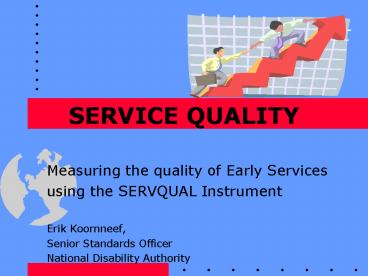SERVICE QUALITY - PowerPoint PPT Presentation
1 / 14
Title:
SERVICE QUALITY
Description:
SERVICE QUALITY Measuring the quality of Early Services using the SERVQUAL Instrument Erik Koornneef, Senior Standards Officer National Disability Authority – PowerPoint PPT presentation
Number of Views:641
Avg rating:3.0/5.0
Title: SERVICE QUALITY
1
SERVICE QUALITY
- Measuring the quality of Early Services
- using the SERVQUAL Instrument
- Erik Koornneef,
- Senior Standards Officer
- National Disability Authority
2
Definitions of Quality
- Quality is what the customer says it is
- You only know what quality is when it is absent
- Quality is conforming to certain requirements
and standards - Quality is excellence
3
Definitions of Quality
- Quality is meeting (and where possible
exceeding) the assessed needs and defined
expectations of the customer - through efficient and effective
- management and processes.
4
Measuring Quality
- Different ways of measuring quality
- Inspections
- Audits
- Reviews
- Assessments by staff and management
- Customer satisfaction
- Interviews
5
The GAPS Model
- Developed in 80s by three American researchers.
- Research focused on the perceptions of customers
of banks, telephone companies and retailers. - Conclusion customers are the only real judges of
quality. - The GAP means that what customers EXPECT (what
customers believe should happen) of a service is
not always the same as what they PERCEIVE (the
view of the customer of what actually happened).
6
The GAPS Model
- Researchers developed and tested this GAPS Model
and subsequently came up with a questionnaire
that measures the Expectations and Perceptions of
Customers. - If the Expectations are higher than the
Perceptions the quality of the service is
perceived to be LOW (disappointment, it just
didnt live up to the expectations) and if the
Perceptions are higher than the Expectations the
perceived quality is high (pleasant surprise)
7
The GAPS Model
- The questionnaire or survey used to measure the
Expectations and Perceptions of Customers is
called the SERVQUAL Instrument. - 22 items measuring the Expectations and
Perceptions. - SERVQUAL has been used frequently in the last 2
decades across different types of services, for
example hospitals, travel industry, hotels,
dentists. - Not yet used to measure Quality in services for
people with intellectual disability
8
The Results
- Questionnaires sent May 2002
- Response rate customers 74.2, staff 80
- Customers length of service 72.7 less than 2
years - Benchmarking results with another similar service
provider - Scores ranges between 1 (Strongly Disagree) to 7
(Strongly Agree)
9
The Results
10
The Results
- Highest negative Gap scores (Quality is
perceived to be low) - Visually appealing facilities and materials
(Tangibles) - Completion of promised tasks (Reliability)
- Provision of exact/promised service (Reliability)
- Promptness of service (Responsiveness)
- Convenient operating hours (Empathy)
11
The Results
- Highest positive Gap scores (Quality is
perceived to be high) - Staff are neat-appearing (Tangibles)
- Safe feeling regarding staffs work (Assurance)
- Having customers best interests at heart
(Empathy)
12
The Results
13
The Results
14
Conclusion
- High expectations and perceptions, in comparison
with other studies - Biggest Gap relate to Tangibles and Reliability
- Small gap between customers expectations and
staffs perceptions of these expectation,
indicating that staff are quite aware of
customers expectations - Staff overestimate the customers importance
ratings in relation to Empathy and underestimate
customers ratings regarding Tangibles and
Responsiveness































